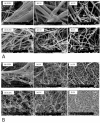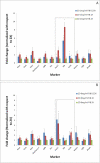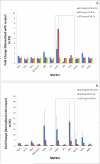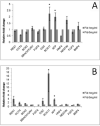Inducing endoderm differentiation by modulating mechanical properties of soft substrates
- PMID: 23008262
- PMCID: PMC4130804
- DOI: 10.1002/term.1602
Inducing endoderm differentiation by modulating mechanical properties of soft substrates
Abstract
Early embryonic stem cell (ESC) differentiation is marked by the formation of three germ layers from which all tissues types arise. Conventionally, ESCs are differentiated by altering their chemical microenvironment. Recently however, it was established that a mechanical microenvironment can also contribute towards cellular phenotype commitment. In this study, we report how the cellular mechanical microenvironment of soft substrates affects the differentiation and phenotypic commitment of ESCs. Mouse ESCs were cultured in a fibrin hydrogel matrix in 2D and 3D cultures. The gelation characteristics of the substrates were modulated by systematically altering the fibrinogen concentration and the fibrinogen-thrombin crosslinking ratio. Analysis of the ESCs cultured on different substrate conditions clearly illustrated the strong influence that substrate physical characteristics assert on cellular behaviours. Specifically, it was found that ESCs had a higher proliferation rate in gels of lower stiffness. Early differentiation events were studied by analyzing the gene and protein expression levels of early germ layer markers. Our results revealed that lower substrate stiffness elicited stronger upregulation of endoderm related genes Sox17, Afp and Hnf4 compared to stiffer substrates. While both 2D and 3D cultures showed a similar response, the effects were much stronger in 3D culture. These results suggest that physical cues can be used to modulate ESC differentiation into clinically relevant tissues such as liver and pancreas.
Keywords: differentiation; embryonic stem cells; endoderm; fibrin hydrogel; mechanical properties; soft substrates.
Copyright © 2012 John Wiley & Sons, Ltd.
Figures










References
-
- Antoine M, Wirz W, Tag CG, Mavituna M, Emans N, Korff T, et al. Expression pattern of fibroblast growth factors (FGFs), their receptors and antagonists in primary endothelial cells and vascular smooth muscle cells. Growth Factors. 2005;23(2):87–95. - PubMed
-
- Banerjee I, Sharma N, Yarmush M. Impact of co-culture on pancreatic differentiation of embryonic stem cells. Journal of Tissue Engineering and Regenerative Medicine. 2010 n/a-n/a. - PubMed
-
- Blombäck B, Bark N. Fibrinopeptides and fibrin gel structure. Biophysical Chemistry. 2004;112(2-3):147–151. - PubMed
-
- Blum M, Gaunt SJ, Cho KWY, Steinbeisser H, Blumberg B, Bittner D, et al. Gastrulation in the mouse: The role of the homeobox gene goosecoid. Cell. 1992;69(7):1097–1106. - PubMed
Publication types
MeSH terms
Substances
Grants and funding
LinkOut - more resources
Full Text Sources

